Home page: www.treks.org
Table of Contents "On the road
to Kabul and other short stories of treks"
Snow blind on Mera Peak,
October 1998
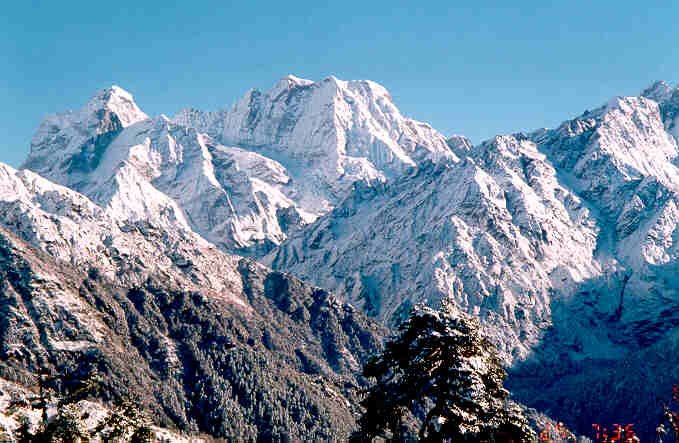
Mera Peak (middle). West summit (middle left) 6486 m, Central summit (middle)
6476 m. View from the South.
Rokus
stumbled along hitting rocks all the time on the narrow mountain trail as he could not see. He was
snow blind, his eyes fully taped up by a French doctor as they got burned two
days ago on the Mera Glacier. We still needed two days to reach Lukla at 2700 m
and had to cross a steep, 4900 m pass.
Mera Peak
Mera Peak
is a 6476 m mountain in the Everest region and famous as a Trekking Peak. It is
the highest mountain in Nepal that is so easy, basically a walk-up along the
Mera Glacier, but only when the weather is fine.
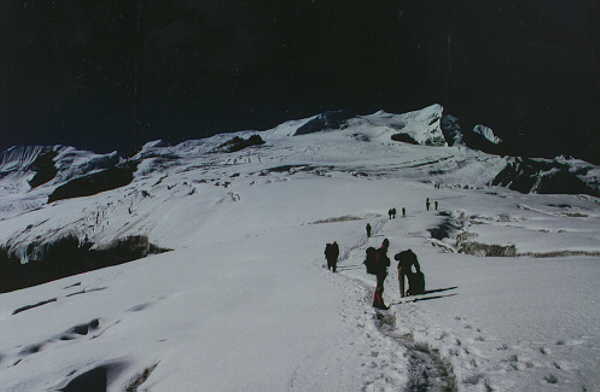
Mera Glacier, just before Mera La Pass (5400 m), towards the left. View at
Mera Peak.

Mera Glacier, view at Mera Peak.
When the weather turns to
snow showers, it can be very bad. At this altitude you could get a meter of
fresh snow in two days covering the numerous glacier crevasses as Jeroen and
Bram found out in fall of 1999. An easy three hour trip from High Camp at 5800
m to Khare at 4900 m, turned into a 12 hour snow plough adventure.
Mera Base
Camp at Khare at 4900 m has a few very simple tea houses, basically four walls
of piled up rocks and covered with a blue plastic tarp.
High camp
is on the Mera Glacier at 5800 m near Rocky Ridge. A single camp can be set up
at the “eagles nest”, a rocky part next to Rocky Ridge with a km high shear
drop and a splendid view at the valley leading to Panch Pokhari and the Amphu
Lamptsa Pass East of Mera Peak.
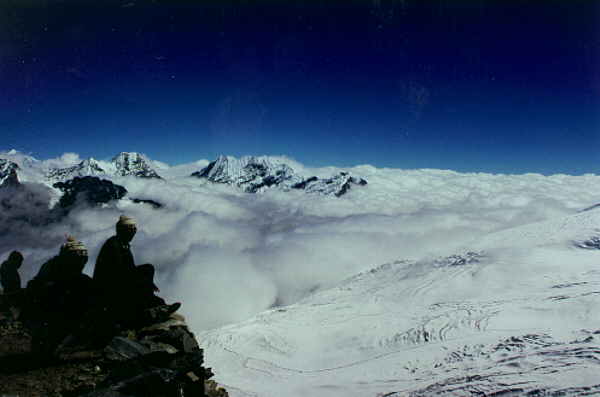
Rocky Ridge Camp, view to the North East at Baruntse.
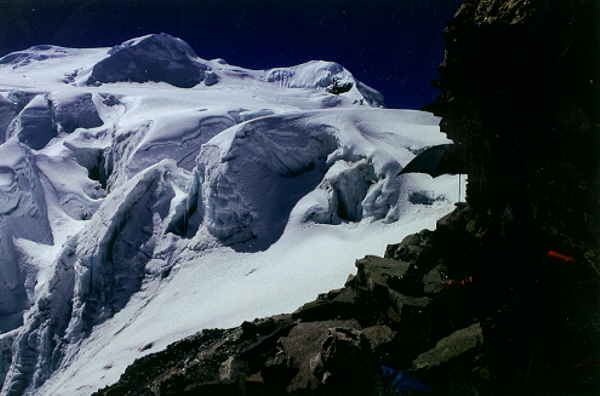
Rocky Ridge Camp, view South. Mera glacier dropping off. Mart sheltering
under an umbrella against the fierce midday sun.
Rokus was
very keen in trying to summit the top of Mera Peak, his last and only chance he
felt as he was already 55.
Summit day
Nobody
managed to sleep last night in the Rocky Ridge High Camp at 5800 m, it is simply
too high. Everybody had headaches and most of us used pain killers to fight it. I also took Diamox as it is know as a
medicine against high altitude sickness. At high altitude the oxygen exchange
through the arteries malfunctions by leaking fluids in the lungs causing a
cough and brains causing a headache.
We got up
at 2 AM but it took two hours to get ready, only to get up, have breakfast and
put on the gear. The crampons gave a considerable delay.
We left in
two groups of 5 having a dead calm weather of -10 Celsius. In the morning there
is more oxygen in the air as the morning air is still cold, I have been told.
This is the main reason why we get up so early, not to reach the top at sun
rise as this is just a bonus.
At 7.45 AM
my group reached the top but not after loosing one person as we went too fast.
The last hour we stopped every minute to recover but the going was very easy, a
gentle walk-up. Only the last 30-40 m to the reach the snow-covered cone of the
6476 m central summit were steep.
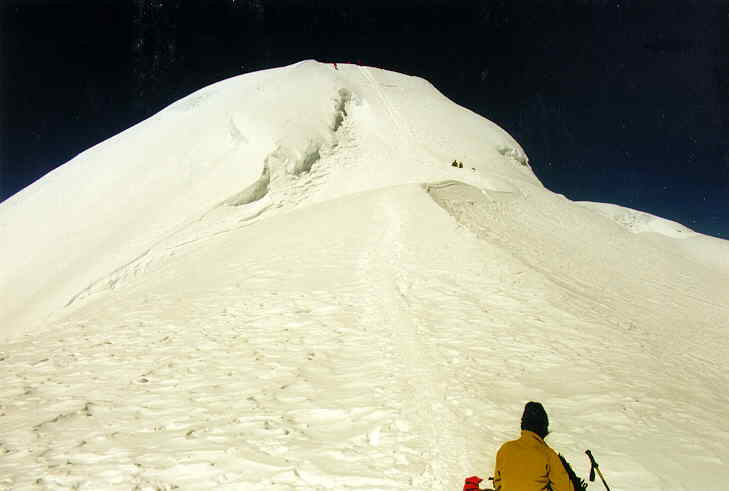
Snow covered cone of he central summit of Mera Peak.
It is a special feeling to
stand so high and see the nearby (15 km) pyramid of Everest towering so high
above the Nutpse.

Top of Mera peak, view North to Nuptse (middle left), Everest (highest
pyramid peak middle) and Lotse (right of Everest).
We stayed only 5 minutes, a
howling wind at -12 to -15 Celsius made the top a no picnic area. In the far
distance we saw Rokus and his group. They were 1 hour behind but were going
steadily.
On the way
down Tsiring, our Sherpa climbing guide said he forgot his sun glasses and I
gave him my second set. The sun was now out an although slightly covered up by
a haze and a few clouds, the light was still very strong, enhanced by glacier
reflection.
Rokus
reached the top at 9 AM and was very happy.
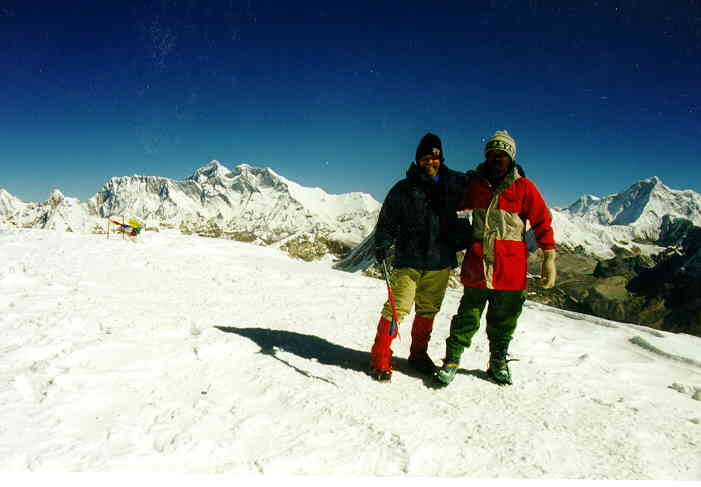
Rokus with Phurba Sherpa on Mera Peak.
Going down, he was very tired
and had trouble finding the clearly marked trail due to high altitude sickness
causing a loss of sense of orientation. Rokus did not pull out his sun glasses
as the weather was now increasingly cloudy. He finally reached base camp at 2
PM.
The next morning
The next
morning Rokus complained about burning eyes and said that possibly they got
burned as he did not wear sun glasses yesterday.
Later that
day, back in Tangnag, the pain increased and a French doctor looked at his
eyes. He took a drastic measure by taping up the eyes immediately. Several
times a day eye drops would be applied and the doctor recommended Rokus should
keep his eyes from getting any light.
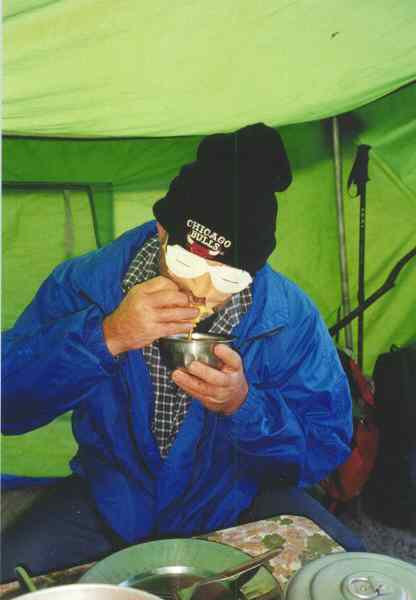
Rokus with eyes taped up, trying to eat.
We still had two days to go
before we could reach Lukla. The first day was hell. Rokus couldn’t walk,
stumbling over the rocks on the uneven mountain trail. We tried to have him
carried by a porter but carrying 85 kg uphill was even too much for them. They
would only last for 5 to 10 minutes and Rokus position on the back was very
uncomfortable. Walking and stumbling was better. With beaten up feet, and 5
hours later we finally arrived in the camp before the 4900 m pass.
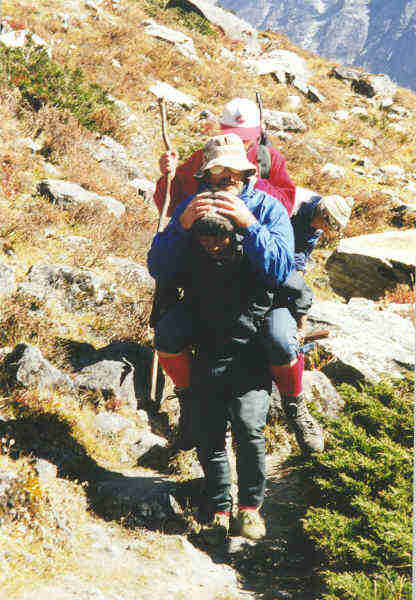
Rokus carried by porter on the mountain trail.
The next day
we would cross the pass and this would be a10 hour day. I estimated that at 12
AM we would be at the pass and take another 5 hours to go down to Lukla from
4900 m to 2700 m.
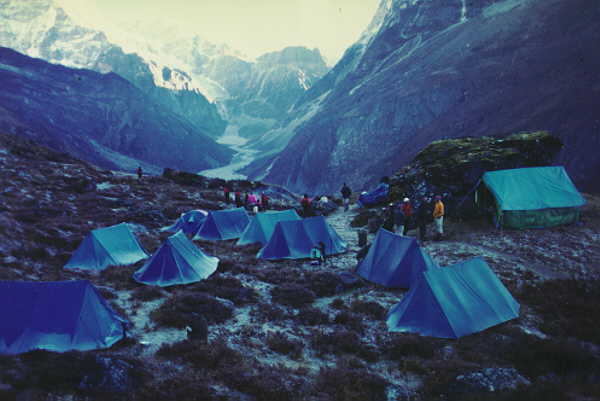
Last day camp at 4500 m, early morning frost on tents, view at Tangnag.
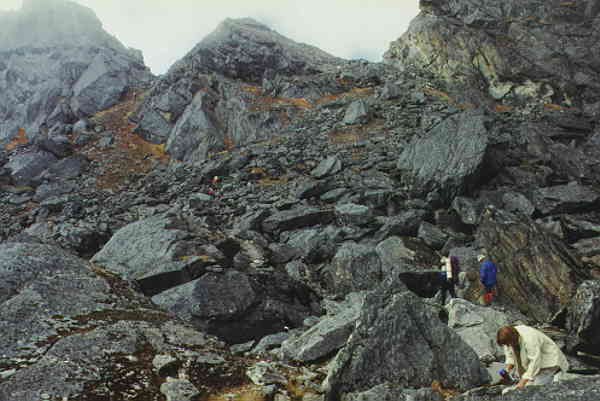
Rocky approach to the 4900 m pass to Lukla. Rokus in blue.
As the
weather was a bit cloudy and Rokus felt a lot better he decided to take off the
bandage and go for it. I agreed, this was the only way to make it back in time
to Lukla.
Rokus left
ASAP and was always in the front that day. He reached Lukla at 4 PM and quickly
covered up his eyes.
The next
morning we took him to the doctors assistant in Lukla and got more eye drops.
Rokus kept on complaining that his eyes were very sore and had sticky lime on
his eyes. He wondered if it would ever heal.
Epiloque
Rokus had
burning eyes for the next six to nine months when it finally healed.
Being snow
blind or more precisely, to have a sun burn of the eyes is no joke. Always use
sun glasses and to help others, always carry two in case someone looses a set.